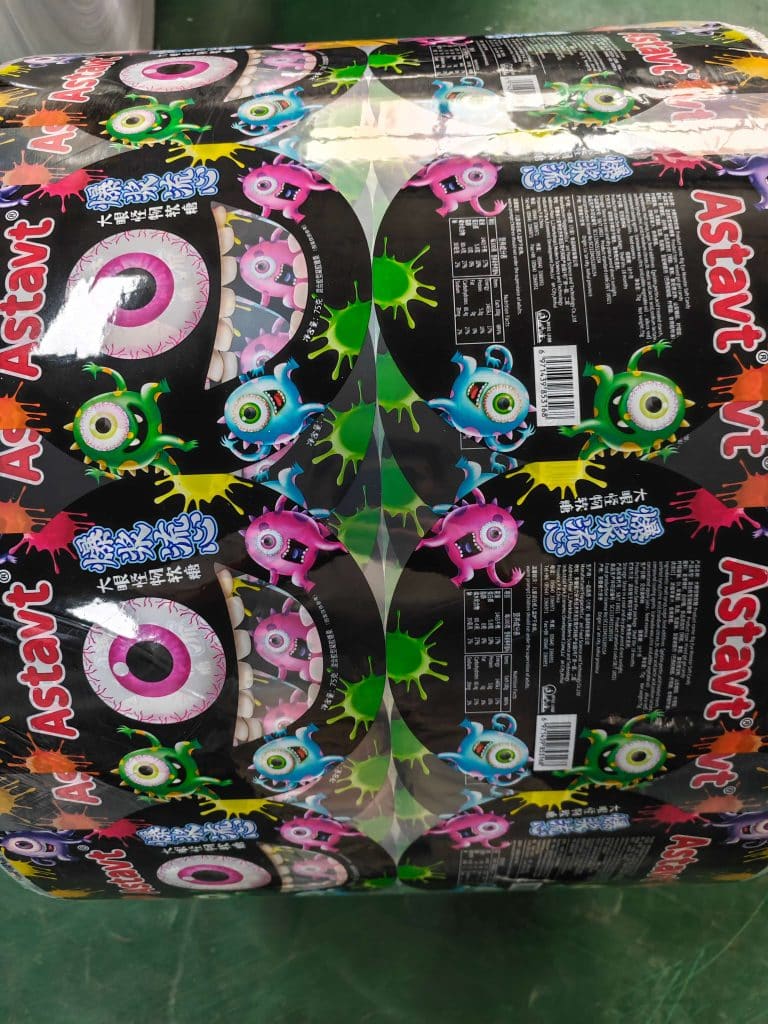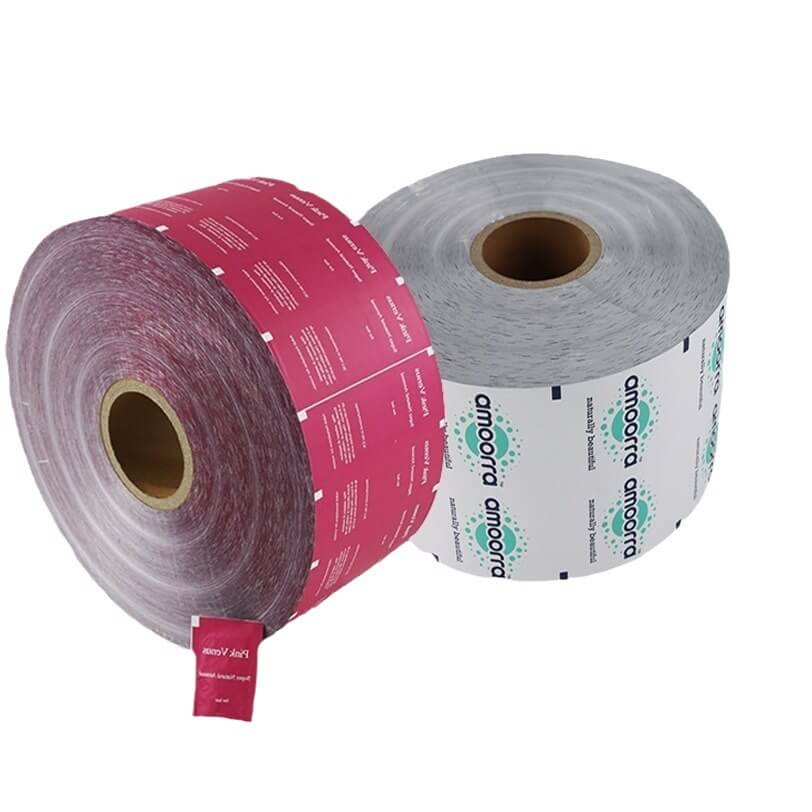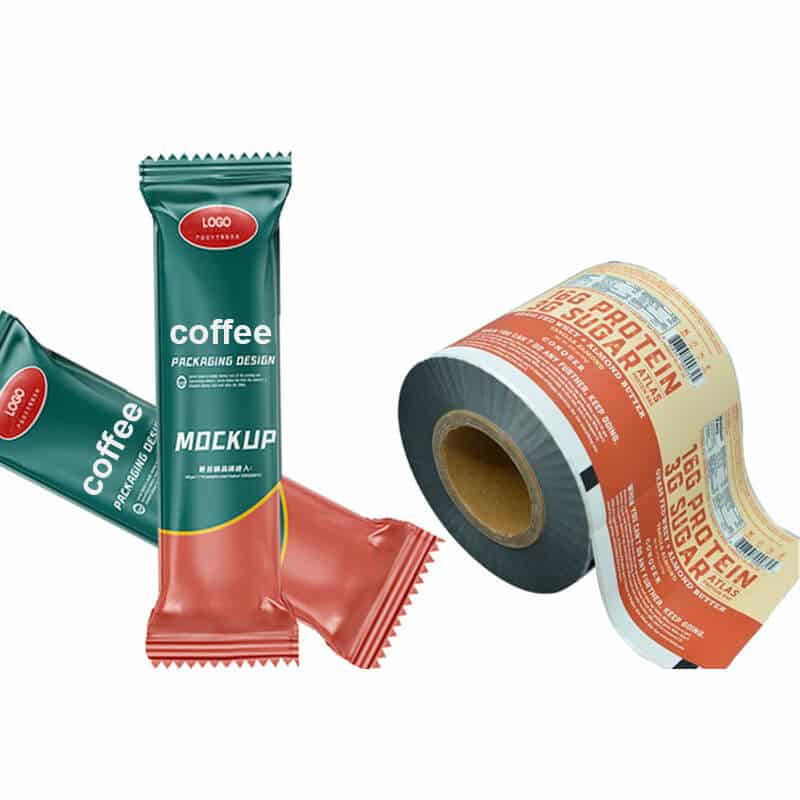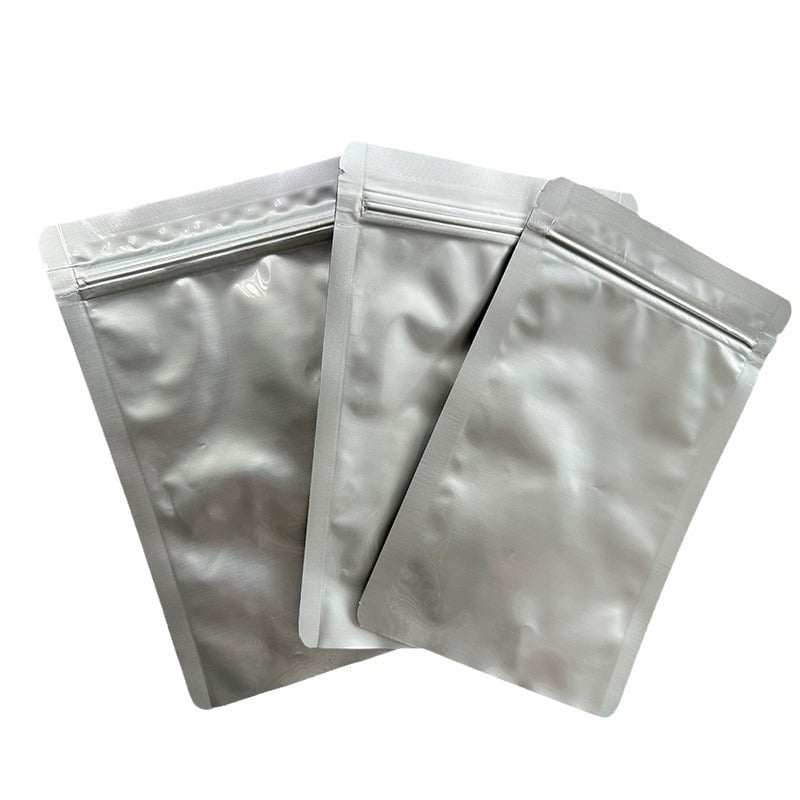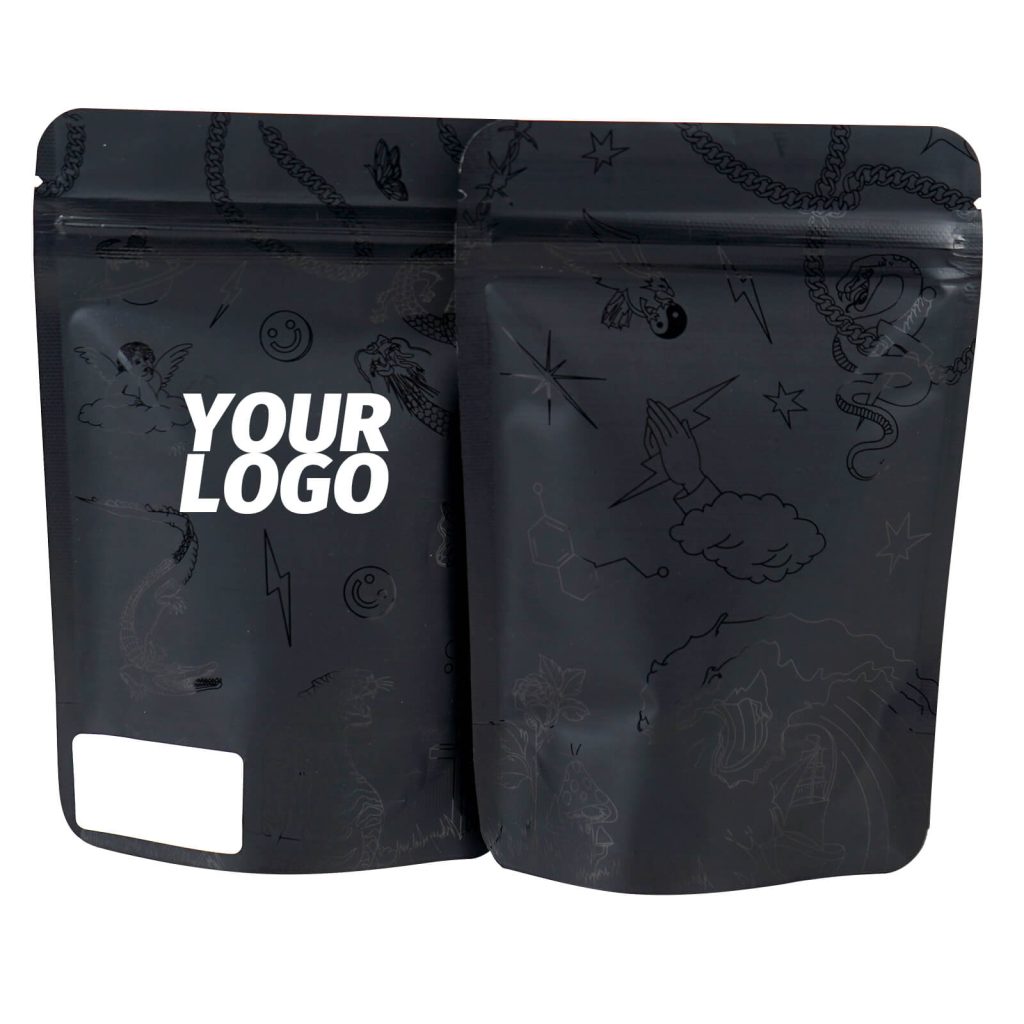What is an aluminum foil bag?
An aluminum foil bag, also known as a foil pouch or barrier bag, is a packaging made from a laminate of aluminum foil and other materials, such as polyester or polyethylene. These bags are designed to provide a high level of barrier protection against moisture, light, oxygen, and other environmental factors that can affect the quality and shelf life of the products they contain.
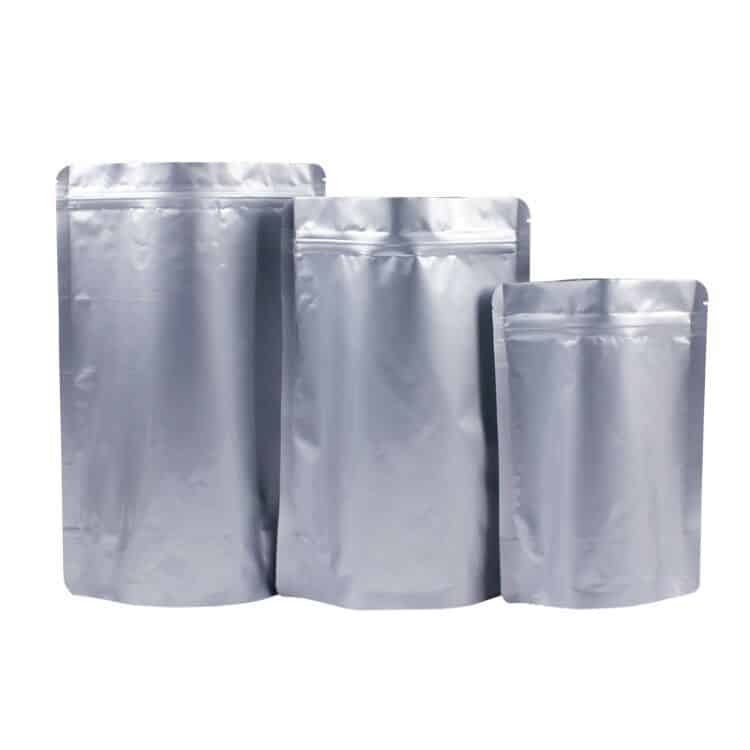
Construction of an aluminum foil bag
Material: The primary material used to make an aluminum foil bag is aluminum foil. This thin sheet of aluminum is highly reflective and has excellent barrier properties. The aluminum foil can be laminated to other materials, such as polyester or polyethylene, to create a multi-layer bag that provides even more barrier protection.
Size and shape: Aluminum foil bags can be made in various sizes and shapes, depending on the product they will be used to package. They can be stand-up pouches, gusseted side bags, flat-bottom bags, and many more. Some bags have a re-sealable zipper or a heat-sealable lip, and others have a tear notch for easy opening.
Printing: They can also be printed with various designs and branding elements, such as logos, product information, and nutritional information.
Uses of an aluminum foil bag
Food Packaging: aluminum foil bags are widely used in the food industry to package various products, including dried foods, snacks, coffee, tea, and spices. They also package fresh and frozen foods, such as meat, seafood, and vegetables.
Pharmaceuticals and medical products: aluminum foil bags are also used for packaging pharmaceuticals and medical products, such as pills and powders, to protect them from moisture and other environmental factors affecting their effectiveness.
Industrial and commercial products: Some industrial and commercial products, such as powders, chemicals, and electronics, are also packaged in aluminum foil bags to protect them from moisture and other environmental factors that can cause damage during storage and transportation.
Advantages of using aluminum foil bag
Barrier properties: The aluminum foil provides an excellent barrier against moisture, light, oxygen, and other environmental factors that can affect the quality and shelf life of the products they contain.
Lightweight and durable: The bags are lightweight yet durable and can be easily transported and stored.
Customizable: They can be customized in a variety of sizes and shapes and can be printed with a variety of designs and branding elements.
Re-sealable: Some bags come with re-sealable zippers, which makes it convenient for the consumer to use the product multiple times and keep it fresh.
Cost-effective: they are a cost-effective solution for packaging and storage compared to other forms of packaging, such as glass or metal cans.
Is an aluminum foil packaging bag toxic?
An aluminum foil packaging bag is not toxic.
Safety of aluminum foil:
Aluminum foil, also known as tin foil, is made from an aluminum alloy that contains more than 92% aluminum. It is a food-grade material that is non-toxic and safe for food contact. It has been used for many decades in food packaging and preparation and in a wide range of other applications.
Effect on food:
Aluminum foil can be safely used for cooking, packaging, and storing food. It can be used to wrap food and to line cooking pans to prevent food from sticking. When used in cooking, small amounts of aluminum may leach into food. However, the levels of aluminum that leach into food are considered safe for consumption. According to the World Health Organization (WHO), the acceptable daily intake of aluminum is up to 40 milligrams per kilogram of body weight per day.
Effect on the environment:
Aluminum foil is not harmful to the environment when discarded in a landfill. It is made from a natural resource, aluminum, which is abundant and recyclable. Aluminum foil can be recycled and can be recycled again and again without losing quality.
Overall, aluminum foil is safe to use and easy to recycle; it’s suitable for food packaging and can keep food fresh for a longer time.
Standard materials of aluminum foil bags
Aluminum foil bags, also known as foil pouches or foil sachets, are made from a laminate of a plastic film and aluminum foil. These bags are used for various applications, such as packaging food, pharmaceuticals, and industrial products. This article will provide an overview of the materials commonly used to construct aluminum foil bags and their properties.
Construction Materials
1. Plastic Films
-Polyethylene (PE)
-Polypropylene (PP)
-Nylon (NY)
2 .Aluminum Foil
Thickness is commonly between 6-50 microns.
Plastic Films
Plastic films are the primary component of aluminum foil bags and are used to form the barrier layer that protects the contents of the load from the external environment. The most common plastic films used in the construction of aluminum foil bags are polyethylene (PE), polypropylene (PP), and nylon (NY).
PE is a thermoplastic polymer widely used in the packaging industry because of its low cost and excellent moisture barrier properties. PE films are available in various thicknesses and can be produced in multiple colors.
PP is a thermoplastic polymer similar to PE in terms of its properties and applications. PP films have a slightly higher tensile strength and a higher melting point than PE films, making them suitable for high-temperature applications.
NY is a synthetic polymer known for its high strength and excellent heat resistance properties. NY films are more expensive than PE and PP films, but they are widely used in applications requiring high strength and heat resistance.
Aluminum Foil
Aluminum foil is the other primary component of aluminum foil bags. The aluminum foil is an additional barrier layer that protects the bag’s contents from light, oxygen, and moisture. Aluminum foil is a thin sheet of metal typically between 6-50 microns thick. This thin sheet is then laminated to the plastic films to form a barrier layer.
Properties
- High barrier properties
- Lightweight
- Flexibility
- Suitable for packing food and protecting them from light, oxygen, and moisture
- It can be used for heat sealing
- Recyclable
- Aluminum foil bags have several properties that make them well-suited for packaging applications.
One of the most important properties of aluminum foil bags is their high barrier properties, which protect the contents of the bag from light, oxygen, and moisture. This makes them ideal for packaging food products, as they help maintain the contents’ freshness and flavor.
Aluminum foil bags are also lightweight and flexible, which makes them easy to transport and handle. This is especially important for applications where the bags will be shipped over long distances or handled by automated packaging equipment.
In addition to their physical properties, aluminum foil bags are also suitable for protecting food. They can be used for heat sealing, which allows them to be quickly closed and re-opened. Additionally, they are recyclable, which is environmentally friendly.
Foil Bag Thickness
Foil bag thickness refers to the physical measurement of the thickness of the material used to construct a foil bag. The thickness of a foil bag can be measured in various units, such as mils (thousandths of an inch) or microns (thousandths of a millimeter). A foil bag’s thickness can significantly impact its overall performance, including its strength, puncture resistance, and barrier properties.
Factors that Affect Foil Bag Thickness
Several factors can affect the thickness of a foil bag, including the intended use of the bag, the type of material used, and the manufacturing process. For example, a foil bag designed for food storage may require a thicker fabric to provide good barrier properties and protect the contents from contamination. Similarly, a foil bag used in a harsh industrial environment may require a thicker material to withstand abrasion and resist punctures.
The type of material used in the construction of a foil bag can also significantly impact its thickness. Some common materials used to make foil bags include aluminum, polyethylene, and laminated fabrics, each with different properties and thicknesses.
The manufacturing process can also affect the thickness of a foil bag. Some methods, such as Extrusion and lamination, can produce a thicker and stronger film, while others, like Calender, have a thinner and softer film with different mechanical properties.
Thickness Standards and Tolerances
Foil bag thickness is typically measured in mils (thousandths of an inch) or microns (thousandths of a millimeter) and is commonly reported as a range rather than a single value. This range is known as the thickness tolerance, representing the deviation from the target thickness allowed for a given batch of bags.
In addition, many different standards are used to measure and specify the thickness of foil bags, such as ASTM D1777 and D374, ISO 534 and ISO 4593, and JIS P8126. Each of these standards is different, and the methods used to measure the thickness can also vary. Therefore, it is essential to understand the standard used when specifying or evaluating the thickness of a foil bag.
In conclusion, Foil Bag Thickness is a critical factor to consider when selecting and designing a foil bag, as it directly affects the bag’s mechanical properties, barrier properties, and performance in different use cases.
Aluminum foil bag product features Appearance.
The Appearance of Aluminum Foil Bag:
1.Shape and Size:
The aluminum foil bag has a generally rectangular shape, with the length, width, and gusset (depth of the bag) dimensions determined by the intended use and contents of the pack. The bag may be sealed on one or both ends and may have a tear-off or heat-sealed opening for easy access to the contents.
2.Material:
The bag is made of aluminum foil, a thin sheet of aluminum made less than 0.2mm thick. Aluminum is highly reflective and can resist heat, light, and moisture, making it an ideal packaging material.
3.Color and Printing:
The aluminum foil bags are usually silver in color due to the metallic nature of the aluminum. Still, they can also be printed with various colors and designs to enhance their Appearance and make them more attractive to consumers. The printing is usually done on the front and back panels of the bag using a variety of printing techniques, such as offset printing, silk screen printing, and digital printing.
4.Texture and Feel:
The aluminum foil bags have a smooth and shiny surface due to the reflective nature of the aluminum. The bags are lightweight and flexible, which makes them easy to handle and package. They may have a slight crinkle sound when they are moved or taken due to the aluminum foil being flexible.
Closure:
The bag can be closed through various means, such as heat sealing, adhesives, or a zipper. The type of closure used will depend on the bag’s contents and the desired level of reusability.
Overall, the aluminum foil bag is a versatile and durable packaging option; its reflective and moisture-resistant nature makes it ideal for packaging various products such as food, medical products, and other items that require protection from heat, light, and moisture.
Aluminum foil bag product structure
An aluminum foil bag, also known as a foil pouch, is a packaging made from a combination of aluminum foil and other materials such as paper, plastic, or fabric. The structure of an aluminum foil bag can vary depending on the intended use and the specific materials used in its construction. However, some common elements of aluminum foil bag structure include the following:
Aluminum Foil Layer:
The aluminum foil layer is the primary barrier that keeps the bag’s contents fresh and protected from external elements. The foil is typically between 6 and 20 microns thick and is often coated with a layer of plastic or paper to provide extra strength and sealability.
Inner Lining:
The inner lining of an aluminum foil bag is typically made from a food-grade material such as polyethylene (PE), polypropylene (PP), or nylon. These materials provide a barrier that helps prevent the bag’s contents from leaking or absorbing moisture. Some bags also have additional layers of materials, such as paper, to provide extra cushioning and protection.
Zipper or Seal:
The top of an aluminum foil bag is typically sealed using a zipper or a heat seal. Zippers are often utilized for loads intended to be resealed after opening, while heat seals are used for bags designed to be used once and then discarded.
Printing and Labeling:
Many aluminum foil bags also feature printing and labeling on the outside. This might include brand, product, ingredients, or nutritional information.
The labeling could be done through offset printing, screen printing, or hot stamp printing.
Others:
Additional layers, such as paper or plastic, may be added to the bag structure to provide extra cushioning, strength, or barrier properties. Some bags also include features such as tear notches, which make it easier to open the suitcase or hang holes, which allow the bag to be displayed on hooks or racks.
Overall, the structure of an aluminum foil bag is designed to provide protection, freshness, and convenience for the contents while also providing an attractive, informative, and appropriate packaging solution for the product inside.
Scope of application of aluminum foil bag
Aluminum foil bags, also known as aluminum foil pouches or foil packaging, are packaging made from a layer of aluminum foil and one or more layers of other materials. These bags are commonly used for packaging various products, including food, pharmaceuticals, and industrial items.
Uses in Food Packaging
One of the most common uses of aluminum foil bags is in food packaging. The aluminum foil provides a barrier against light, moisture, and air, which helps preserve the food’s freshness and flavor. These bags are commonly used for packaging coffee, tea, nuts, and dried fruits. They are also often used for vacuum-sealed products like meat, seafood, and cheese.
Uses in Pharmaceuticals
Aluminum foil bags are used extensively in the pharmaceutical industry to package tablets, capsules, and powders. The aluminum foil provides a barrier against moisture and light, which helps to keep the medication fresh and potent. These bags are commonly used for packaging both prescription and over-the-counter drugs.
Uses in Industrial Packaging
In addition to food and pharmaceuticals, aluminum foil bags are also used for packaging various industrial items. These bags can package items such as chemicals, fertilizers, and paint. The aluminum foil provides a barrier against moisture and light, which helps preserve the product’s quality and integrity.
Advantages of Aluminum Foil Bags
Aluminum foil bags have several advantages over other types of packaging. They provide an excellent barrier against light, moisture, and air. This helps to preserve the freshness and quality of the product. They are also very durable and puncture-resistant, which helps to protect the product during shipping and handling. Additionally, aluminum foil bags can be printed on, which allows for easy identification and branding of the product.
Conclusion
In summary, aluminum foil bags are a versatile and durable type of packaging that is widely used in various industries. Their excellent barrier properties against light, moisture, and air, puncture resistance, and ability to be printed on make them ideal for packaging food, pharmaceuticals, and industrial products.
Foil Bag Features
Material Properties:
Foil bags are made from a combination of aluminum and plastic materials. The aluminum provides a barrier against moisture, light, and oxygen, while the plastic offers flexibility and durability. The aluminum layer can be as thick as 50 microns, which provides an excellent barrier against moisture, light, and other environmental factors.
Barrier properties:
Foil bags have excellent barrier properties, making them ideal for packaging products sensitive to moisture, light, or oxygen. The aluminum layer in the bag acts as a barrier against these factors, protecting the product inside from degradation. The bags can also be sealed tight, which helps maintain the freshness of the products inside.
Durability:
Foil bags are highly durable and can withstand various temperatures and other environmental conditions. They also resist punctures and tears, making them an ideal choice for products that may be subject to rough handling during shipping or storage.
Versatility:
Foil bags are versatile in terms of design and size. They can be made in a wide range of sizes and shapes to fit any product and can be printed on high-quality graphics for branding and marketing purposes. Additionally, they can be made with features such as zippers or stand-up pouches for ease of use.
Eco-friendly:
Foil bags can be easily recycled and reused; they are made of aluminum, a 100% recyclable material with a high recycling rate.
In conclusion, Foil bags are an excellent choice for packaging a wide range of products due to their excellent barrier properties, durability, and versatility. They are also eco-friendly and made of recyclable materials, making them a good option for sustainability-conscious companies.
What is a washed aluminum bag, and what is the difference between it and aluminized bags?
Washed Aluminum Bags
A washed aluminum bag, also known as a “metalized bag” or “metalized bag,” is a type of packaging made by applying a thin layer of aluminum to the surface of a plastic film. This process is known as metallization or metalizing, and it creates a barrier that helps protect the bag’s contents from light, oxygen, and moisture.
Creating a washed aluminum bag typically involves vaporizing aluminum in a vacuum chamber and depositing it onto a plastic substrate. The aluminum is then “washed” to remove any impurities or excess aluminum, resulting in a smooth and consistent layer of metal on the bag’s surface.
This type of packaging is commonly used for products such as coffee, tea, and dried foods that need to be protected from light, oxygen, and moisture. The aluminum layer helps maintain the product’s freshness by preventing the infiltration of oxygen and light, which can cause oxidation and loss of flavor. Additionally, because aluminum is a highly reflective material, it can also help to block out UV light, which can be harmful to some types of food.
Aluminized Bags
An aluminized bag is a type of packaging made by applying a thin layer of aluminum to one or both sides of a plastic or paper substrate. Similar to Washed Aluminum Bags, this creates a barrier that helps protect the bag’s contents from light, oxygen, and moisture.
This type of packaging is often used for products such as snacks, cereal, pet food, and other dry goods that need to be protected from light, oxygen, and moisture. The aluminum layer helps maintain the product’s freshness by preventing the infiltration of oxygen and light, which can cause oxidation and loss of flavor. Additionally, because aluminum is a highly reflective material, it can also help to block out UV light, which can be harmful to some types of food.
Differences between washed Aluminum Bags and Aluminized Bags
The main difference between washed aluminum and aluminized bags is the process of creating them. Washed aluminum bags are made by depositing a layer of aluminum onto a plastic substrate and then washing away impurities. In contrast, aluminized bags are created by applying a layer of aluminum to one or both sides of a plastic or paper substrate.
Another difference between the two is that washed aluminum bags often have a higher aluminum content than aluminized bags, making them more effective at blocking light and oxygen.
Washed aluminum bags are also more expensive than aluminized bags due to the additional washing step required in manufacturing.
Overall, washed aluminum and aluminized bags protect food from light, oxygen, and moisture and are widely used in food packaging. Still, washed aluminum bags are often seen as having a higher quality and better barrier properties.
What‘s worse for the environment? Zip lock bags or aluminum foil
Both plastic zipper bags and aluminum foil are single-use products that can negatively impact the environment, but each has different environmental concerns.
Impact of Plastic Zipper Bags:
Plastic zipper bags, also known as Ziploc bags or sandwich bags, are made of polyethylene, a type of plastic. They are convenient for packaging and storing food, but they are not biodegradable and can take hundreds of years to break down in the environment. When not disposed of properly, they can end up in the ocean, harming marine life and contributing to the buildup of plastic waste in the sea. Plastic zipper bags also cause plastic pollution on beaches, streets, and other environments.
Impact of Aluminum Foil:
Aluminum foil is a thin sheet of aluminum often used for cooking, packaging, and storing food. It is made from bauxite ore, a type of rock mined from the earth.
Aluminum production creates significant greenhouse gas emissions, contributing to global warming. Though aluminum foils are recyclable, they are usually not recycled because they are too thin and often contaminated by food residue, making them difficult to recycle. As a result, much of the aluminum foil is in landfills, where it can take hundreds of years to decompose.
Comparing both:
While plastic zipper bags and aluminum foil are single-use products that can negatively impact the environment, the main difference is that plastic zipper bags significantly contribute to plastic pollution. In contrast, the production and disposal of aluminum foil contribute to greenhouse gas emissions and landfilling.
Reducing Impact:
One way to reduce the environmental impact of both products is to use reusable containers or bags instead of single-use products. When single-use products are necessary, it is essential to dispose of them properly and recycle them whenever possible. Using both products in moderation would be another way to reduce the environmental impact.
Conclusion:
Overall, plastic zipper bags and aluminum foil can negatively impact the environment. However, the most important thing is to use them responsibly and in moderation, to dispose of them properly, and to recycle them when possible. It is also a good idea to consider more environmentally friendly alternatives whenever possible.
how to seal off aluminum foil bags
Sealing Aluminum Foil Bags
Sealing aluminum foil bags can be done using a few different methods, depending on the type of bag and the contents inside. Here are a few ways to consider:
Heat Sealing
Heat sealing is one of the most common and effective ways to seal aluminum foil bags. This method involves using a heat sealer, a machine that applies heat and pressure to the top of the pack to melt the plastic and create a seal.
First, use a heat sealer to ensure that the bag is clean and dry. Then, place the bag in the heat sealer and press down on the top of the machine to create the seal. This method is best for bags that contain dry goods and are made of thicker, heat-sealable materials.
Ironing
If you do not have access to a heat sealer, you can also use an iron to seal aluminum foil bags. To do this, place the open suitcase on a flat surface and lay a sheet of parchment or waxed paper on top of the pack. Then, press the iron down on top of the article, applying pressure to the entire top edge of the bag. The heat from the iron will melt the plastic and create a seal.
This method is less reliable than using a heat-sealing machine, but it can work for small bags with light contents and bags made of thinner materials.
Taping
Another option for sealing aluminum foil bags is to use tape. This method is more permanent than heat sealing or ironing, but it can be helpful in a pinch. To use tape, apply a strip of tape across the top of the open bag, making sure to press down firmly on the edges to create a tight seal.
This method is only recommended for light contents and short-term storage, as the tape may not hold up well over time.
Sealing Aluminum foil bag with clips
Another option is using clips or clothespins to seal your aluminum foil bag. This is the most straightforward method and requires no extra equipment. Place your food or items in the bag, close the top, and then secure it with a clip or clothespin.
This method is less reliable than heat sealing or ironing, But it’s great for short-term storage and is perfect for new open bags of snacks.
In conclusion, the most efficient and reliable method for sealing aluminum foil bags is by using the heat sealing method, but if you don’t have access to a heat sealing machine, Ironing, Taping, or using clips can also be used to seal your aluminum foil bags.
where to store aluminum foil and Ziploc bags
Storage of Aluminum Foil and Ziploc Bags
When it comes to storing aluminum foil and Ziploc bags, there are a few things to consider to ensure that they stay in good condition and are easily accessible when needed.
Proper Location
One of the most important things to consider when storing aluminum foil and Ziploc bags is the location. These items should be stored in a dry and cool place, away from any sources of heat or moisture. A pantry or cabinet not located near the stove or sink is a good option. This will prevent the aluminum foil from becoming bent or damaged and keep the Ziploc bags from becoming moist and less effective at keeping food fresh.
Organization
Another important aspect of storing aluminum foil and Ziploc bags is keeping them organized. Keeping them in a designated container or drawer can be helpful, making them easy to find when needed. This could be as simple as using a box or bin, or it could be a more advanced solution like using a pull-out drawer or lazy susan to make it easy to access the items.
Labeling
Labeling the container or drawer where the aluminum foil and Ziploc bags are stored is also a great way to make it easy to find what you need. This could be as simple as writing the item’s name on a piece of tape and sticking it to the container, or it could be as advanced as using a labeling machine. This will help you quickly identify which bag or roll of aluminum foil you are looking for and prevent you from searching through multiple containers or drawers.
Storage Recommendation
It is essential to keep the roll tightly wrapped in its original packaging when storing aluminum foil. This will prevent the foil from becoming bent or damaged and will also prevent it from losing its shape. It is also a good idea to store the aluminum foil so that it does not get crushed or compressed and is easy to pull off.
When storing Ziploc bags, keeping them in their original packaging or a plastic container is best. This will help keep them organized and prevent them from becoming bent or damaged. It is essential to ensure the bags are sealed properly to avoid the air getting inside and damaging the food or the bags themselves.
In conclusion, storing aluminum foil and Ziploc bags properly involves:
- Choosing the correct location.
- Keeping them organized.
- Labeling them.
- Keeping the packaging intact.
By following these simple steps, you can ensure that your aluminum foil and Ziploc bags stay in good condition and are always easy to find when you need them.
Summary
Overall, aluminum foil bags are an excellent choice for packaging a wide range of products due to their barrier properties, durability, and customization options. The aluminum foil provides an excellent barrier against moisture, light, oxygen, and other environmental factors, as the quality and the shelf life of the products they contain. They are also lightweight, customizable, and cost-effective.

